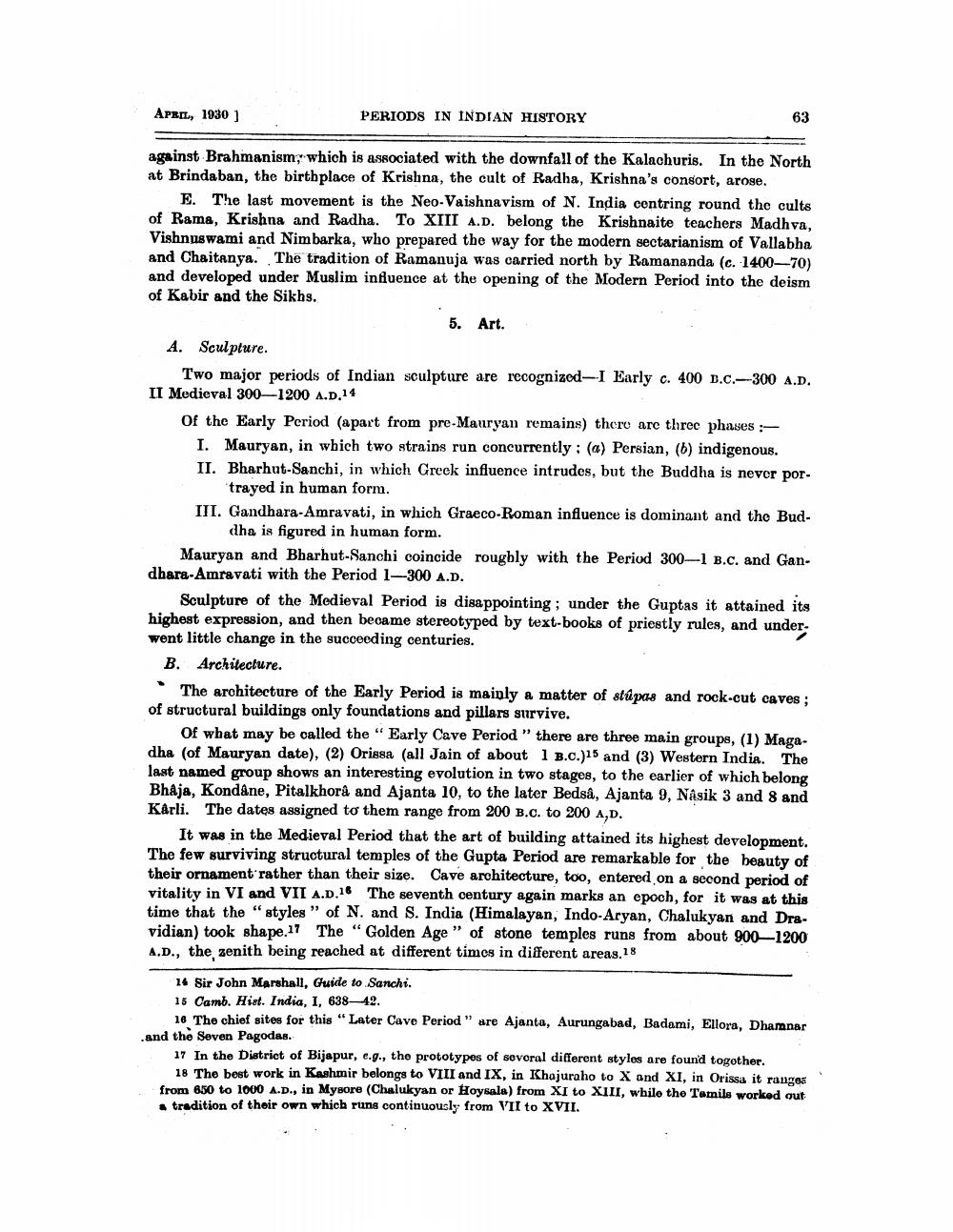________________
APRIL, 1930 ]
PERIODS IN INDIAN HISTORY
63
against Brahmanism, which is associated with the downfall of the Kalaohuris. In the North at Brindaban, the birthplace of Krishna, the cult of Radha, Krishna's consort, arose.
E. The last movement is the Neo-Vaishnavism of N. India contring round the cults of Rama, Krishna and Radha. To XIII A.D. belong the Krishnaite teachers Madhva, Vishnuswami and Nimbarka, who prepared the way for the modern sectarianism of Vallabha and Chaitanya. The tradition of Ramanuja was carried north by Ramananda (c. 1400-70) and developed under Muslim influence at the opening of the Modern Period into the deism of Kabir and the Sikhs.
5. Art. A. Sculpture.
Two major periods of Indian sculpture are recognized-I Early c. 400 B.C.--300 A.D. II Medieval 300-1200 A.D.14
of the Early Period (apart from pre-Mauryan remains) there are three phases :
I. Mauryan, in which two strains run concurrently : (a) Persian, (b) indigenous. II. Bharhut-Sanchi, in which Creek influence intrudes, but the Buddha is never por.
trayed in human form. III. Gandhara-Amravati, in which Graeco-Roman influence is dominant and the Bud
dha is figured in human form. Mauryan and Bharhut-Sanchi coincide rougbly with the Period 300---1 B.C. and Gandhara-Amravati with the Period 1-300 A.D.
Sculpture of the Medieval Period is disappointing ; under the Guptas it attained its highest expression, and then became stereotyped by text-books of priestly rules, and under. went little change in the succeeding centuries. B. Architecture.
The architecture of the Early Period is mainly a matter of stúpas and rock-cut caves ; of structural buildings only foundations and pillars survive.
Of what may be called the "Early Cave Period " there are three main groups, (1) Magadha (of Mauryan date), (2) Orissa (all Jain of about 1 B.C.)15 and (3) Western India. The last named group shows an interesting evolution in two stages, to the earlier of which belong Bhaja, Kondane, Pitalkhorâ and Ajanta 10, to the later Bedså, Ajanta 9, Nasik 3 and 8 and Karli. The dates assigned to them range from 200 B.c. to 200 A,D.
It was in the Medieval Period that the art of building attained its highest development. The few surviving structural temples of the Gupta Period are remarkable for the beauty of their ornament rather than their size. Cave architecture, too, entered on a second period of vitality in VI and VII A.D.16 The seventh century again marks an epoch, for it was at this time that the "styles" of N. and S. India (Himalayan, Indo-Aryan, Chalukyan and Dravidian) took shape.17 The “Golden Age ” of stone temples runs from about 900—1200 A.D., the zenith being reached at different times in different areas.18
16 Sir John Marshall, Guide to Sanchi. 16 Camb. Hist. India, I, 638–42.
10 The chief sites for this "Later Cave Period" are Ajanta, Aurungabad, Badami, Ellora, Dhamnar .and the Seven Pagodas.
17 In the District of Bijapur, e.g., the prototypes of sovoral different styles are found togother.
18 The best work in Kashmir belongs to VIII and IX, in Khajuraho to X and XI, in Orissa it ranges from 650 to 1000 A.D., in Mysore (Chalukyan or Hoysala) from XI to XIII, while tho Tamils worked out tradition of their own which runs continuously from VII to XVII.




